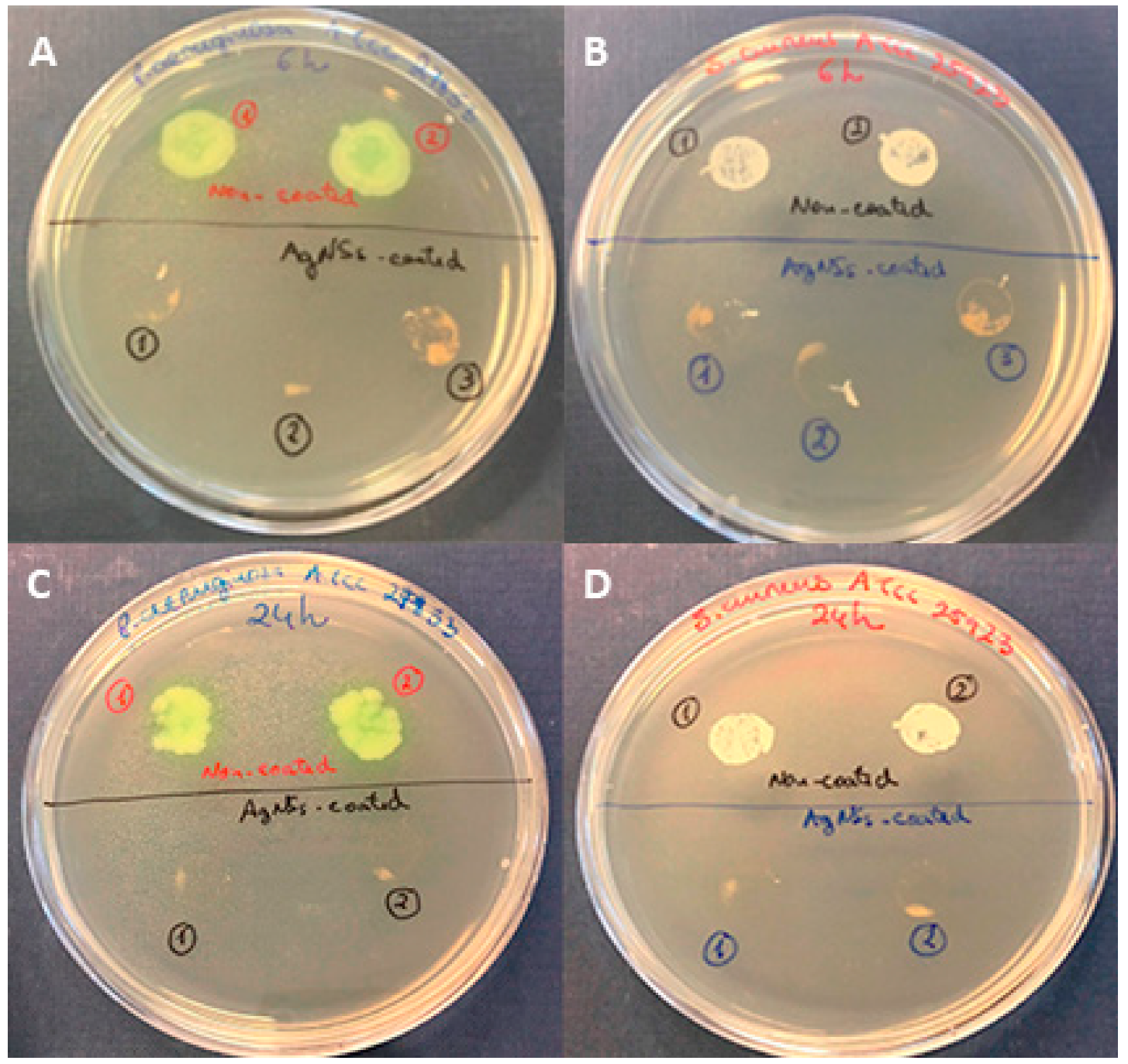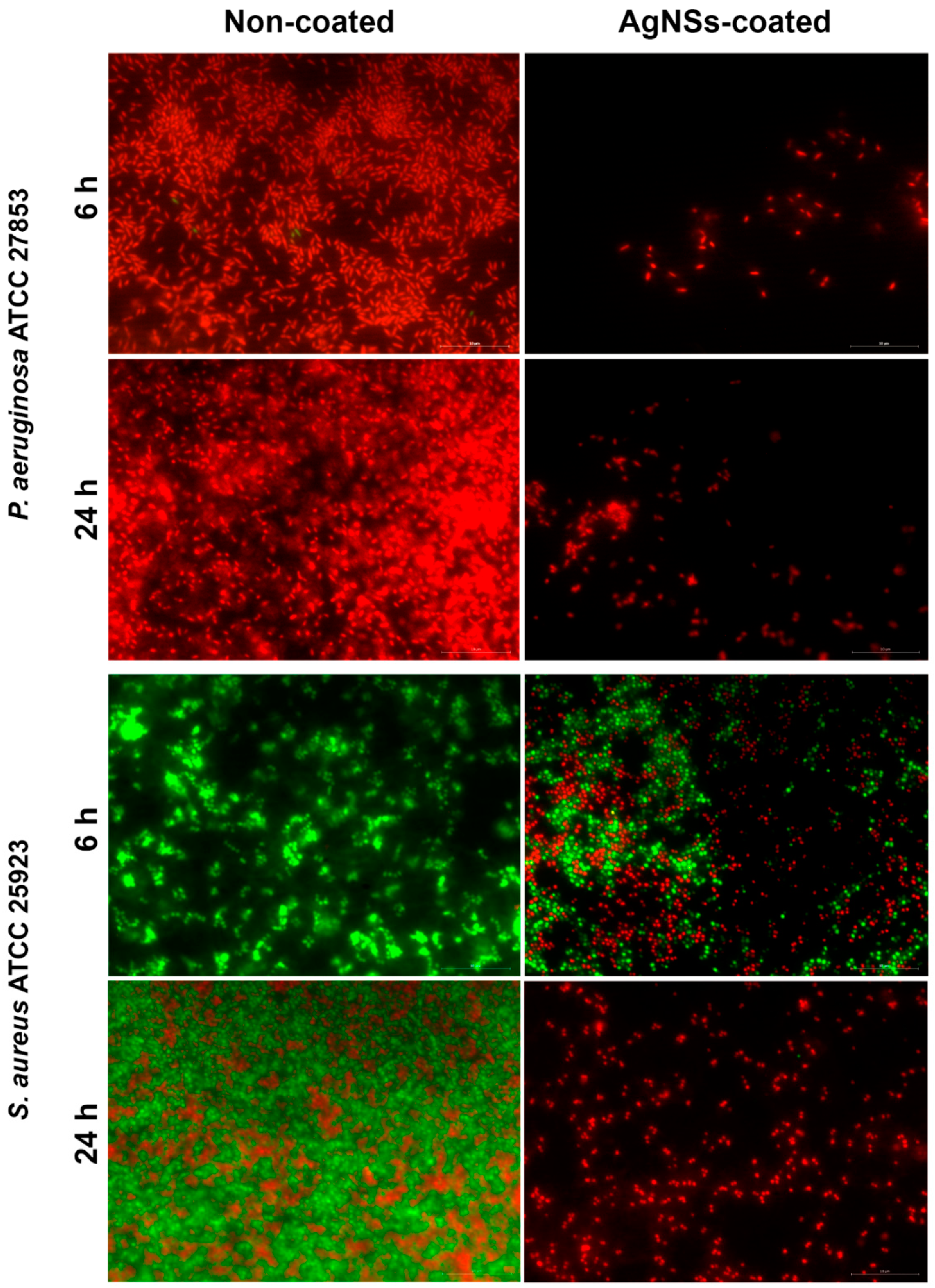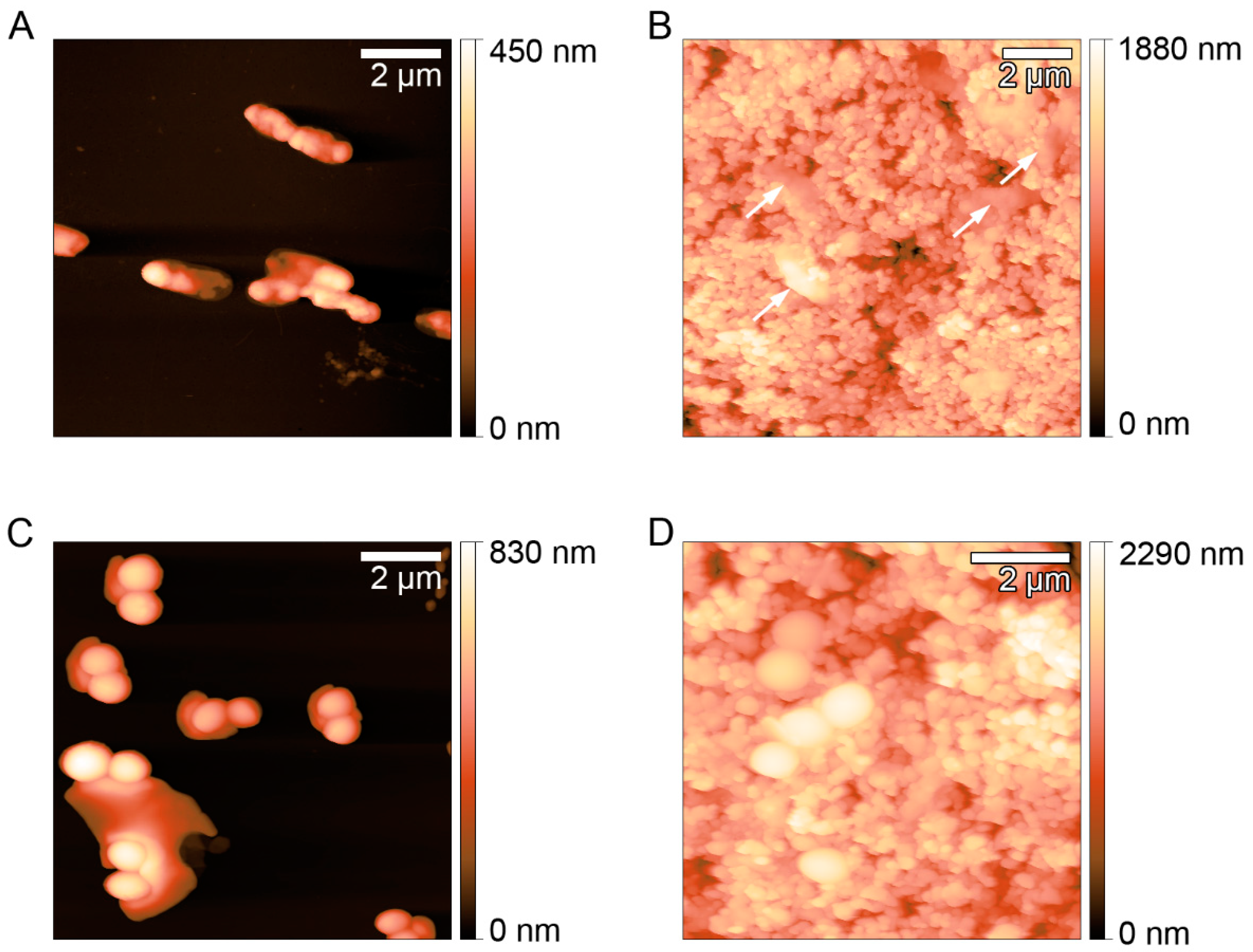Silver Nanostars-Coated Surfaces with Potent Biocidal Properties
Abstract
1. Introduction
2. Materials and Methods
2.1. Synthesis and Characterization of Silver Nanoparticles
2.2. Quantification of Silver in Nanoparticles
2.3. Surface Coating with Silver Nanostars
2.4. Determination of Minimum Inhibitory Concentrations (MICs) of AgNSs and AgNPs
2.5. Effect of AgNSs and AgNPs Suspensions on 24-h Biofilms—Microscopic Analyses
2.5.1. Microscopy of Fluorescence—Live/Dead Staining
2.5.2. Atomic Force Microscopy
2.6. Antimicrobial Testing of AgNSs-Coated Surfaces
3. Results and Discussion
3.1. Characteristics of Silver Nanoparticles (AgNSs and AgNPs)
3.2. Antibacterial Activity of AgNSs Suspensions
3.3. Mild Effect of AgNSs on Bacterial Biofilms
3.4. Biocidal Effect of AgNSs-Coated Surfaces
4. Conclusions
Supplementary Materials
Author Contributions
Funding
Acknowledgments
Conflicts of Interest
References
- Percival, S.L.; Suleman, L.; Vuotto, C.; Donelli, G. Healthcare-associated infections, medical devices and biofilms: Risk, tolerance and control. J. Med. Microbiol. 2015, 64, 323–334. [Google Scholar] [CrossRef] [PubMed]
- Roy, R.; Tiwari, M.; Donelli, G.; Tiwari, V. Strategies for combating bacterial biofilms: A focus on anti-biofilm agents and their mechanisms of action. Virulence 2018, 9, 522–554. [Google Scholar] [CrossRef] [PubMed]
- Lee, W.S.; Hsieh, T.C.; Shiau, J.C.; Ou, T.Y.; Chen, F.L.; Liu, Y.H.; Yen, M.Y.; Hsueh, P.R. Bio-Kil, a nano-based disinfectant, reduces environmental bacterial burden and multidrug-resistant organisms in intensive care units. J. Microbiol. Immunol. Infect. 2017, 50, 737–746. [Google Scholar] [CrossRef]
- Baptista, P.V.; McCusker, M.P.; Carvalho, A.; Ferreira, D.A.; Mohan, N.M.; Martins, M.; Fernandes, A.R. Nano-strategies to fight multidrug resistant bacteria—“A Battle of the Titans”. Front. Microbiol. 2018, 9, 1441. [Google Scholar] [CrossRef]
- Pallavicini, P.; Dacarro, G.; Taglietti, A. Self-assembled monolayers of silver nanoparticles: From intrinsic to switchable inorganic antibacterial surfaces. Eur. J. Inorg. Chem. 2018, 45, 4846–4855. [Google Scholar] [CrossRef]
- Yañez-Macías, R.; Muñoz-Bonilla, A.; De Jesús-Tellez, M.A.; Maldonado-Textle, H.; Guerrero-Sánchez, C.; Schubert, U.S.; Guerrero-Santos, R. Combinations of antimicrobial polymers with nanomaterials and bioactives to improve biocidal therapies. Polymers 2019, 11, 1789. [Google Scholar] [CrossRef] [PubMed]
- Durán, N.; Durán, M.; de Jesus, M.B.; Seabra, A.B.; Fávaro, W.J.; Nakazato, G. Silver nanoparticles: A new view on mechanistic aspects on antimicrobial activity. Nanomedicine 2016, 12, 789–799. [Google Scholar] [CrossRef] [PubMed]
- Tang, S.; Zheng, J. Antibacterial activity of silver nanoparticles: Structural effects. Adv. Healthc. Mater. 2018, 7, e1701503. [Google Scholar] [CrossRef] [PubMed]
- Dakal, T.C.; Kumar, A.; Majumdar, R.S.; Yadav, V. Mechanistic basis of antimicrobial actions of silver nanoparticles. Front. Microbiol. 2016, 7, 1831. [Google Scholar] [CrossRef]
- Khodashenas, B.; Ghorbani, H.R. Synthesis of silver nanoparticles with different shapes. Arab. J. Chem. 2019, 12, 1823–1838. [Google Scholar] [CrossRef]
- Garcia-Leis, A.; Garcia-Ramos, J.V.; Sanchez-Cortes, S. Silver Nanostars with high SERS performance. j. Phys. Chem. C 2013, 117, 7791–7795. [Google Scholar] [CrossRef]
- Gunell, M.; Haapanen, J.; Brobbey, K.J.; Saarinen, J.J.; Toivakka, M.; Mäkelä, J.M.; Huovinen, P.; Eerola, E. Antimicrobial characterization of silver nanoparticle-coated surfaces by “touch test” method. Nanotechnol. Sci. Appl. 2017, 10, 137–145. [Google Scholar] [CrossRef] [PubMed]
- Tortella, G.R.; Rubilar, O.; Durán, N.; Diez, M.C.; Martínez, M.; Parada, J.; Seabra, A.B. Silver nanoparticles: Toxicity in model organisms as an overview of its hazard for human health and the environment. J. Hazard. Mater. 2020, 390, 121974. [Google Scholar] [CrossRef] [PubMed]
- Bastús, N.G.; Merkoçi, F.; Piella, J.; Puntes, V. Synthesis of highly monodisperse citrate-stabilized silver nanoparticles of up to 200 nm: Kinetic control and catalytic properties. Chem. Mater. 2014, 26, 2836–2846. [Google Scholar] [CrossRef]
- Clinical and Laboratory Standards Institute (CLSI). Methods for Dilution Antimicrobial Susceptibility Tests for Bacteria that Grow Aerobically, CLSI Document M07, 11th ed.; Clinical and Laboratory Standards Institute: Wayne, PA, USA, 2018. [Google Scholar]
- Bessa, L.J.; Eaton, P.; Dematei, A.; Placido, A.; Vale, N.; Gomes, P.; Delerue-Matos, C.; Sa Leite, J.R.; Gameiro, P. Synergistic and antibiofilm properties of ocellatin peptides against multidrug-resistant Pseudomonas aeruginosa. Future Microbiol. 2018, 13, 151–163. [Google Scholar] [CrossRef] [PubMed]
- Maiorano, G.; Sabella, S.; Sorce, B.; Brunetti, V.; Malvindi, M.A.; Cingolani, R.; Pompa, P.P. Effects of cell culture media on the dynamic formation of protein-nanoparticle complexes and influence on the cellular response. ACS Nano 2010, 4, 7481–7491. [Google Scholar] [CrossRef]
- De Leersnyder, I.; De Gelder, L.; Van Driessche, I.; Vermeir, P. Influence of growth media components on the antibacterial effect of silver ions on Bacillus subtilis in a liquid growth medium. Sci. Rep. 2018, 8, 9325. [Google Scholar] [CrossRef] [PubMed]
- Radzig, M.A.; Nadtochenko, V.A.; Koksharova, O.A.; Kiwi, J.; Lipasova, V.A.; Khmel, I.A. Antibacterial effects of silver nanoparticles on gram-negative bacteria: Influence on the growth and biofilms formation, mechanisms of action. Colloids Surf. B Biointerfaces 2013, 102, 300–306. [Google Scholar] [CrossRef]
- Hedge, A. Survival of Escherichia coli, Pseudomonas aeruginosa, Staphylococcus aureus on wood and plastic surfaces. J. Microb. Biochem. Technol. 2015, 7, 210–212. [Google Scholar] [CrossRef]
- Shin, Y.; Park, J.; Park, W. Sterilization efficiency of pathogen-contaminated cottons in a laundry machine. J. Microbiol. 2020, 58, 30–38. [Google Scholar] [CrossRef]
- Li, L.; Mendis, N.; Trigui, H.; Oliver, J.D.; Faucher, S.P. The importance of the viable but non-culturable state in human bacterial pathogens. Front. Microbiol. 2014, 5, 258. [Google Scholar] [CrossRef] [PubMed]
- Sachidanandham, R.; Gin, K. A dormancy state in nonspore-forming bacteria. Appl. Microbiol. Biotechnol. 2009, 81, 927–941. [Google Scholar] [CrossRef] [PubMed]
- Zhao, X.; Zhong, J.; Wei, C.; Lin, C.W.; Ding, T. Current Perspectives on viable but non-culturable state in foodborne pathogens. Front. Microbiol. 2017, 8, 580. [Google Scholar] [CrossRef] [PubMed]
- Eaton, P.; Fernandes, J.C.; Pereira, E.; Pintado, M.E.; Xavier, M.F. Atomic force microscopy study of the antibacterial effects of chitosans on Escherichia coli and Staphylococcus aureus. Ultramicroscopy 2008, 108, 1128–1134. [Google Scholar] [CrossRef] [PubMed]
- Bessa, L.J.; Manickchand, J.R.; Eaton, P.; Leite, J.R.S.A.; Brand, G.D.; Gameiro, P. Intragenic antimicrobial peptide Hs02 hampers the proliferation of single- and dual-species biofilms of P. aeruginosa and S. aureus: A promising agent for mitigation of biofilm-associated infections. Int. J. Mol. Sci. 2019, 20, 3604. [Google Scholar] [CrossRef] [PubMed]




| MHBII | TSB | |||
|---|---|---|---|---|
| nmolAgNSs·dm−3 | μgAg/mL | nmolAgNSs·dm−3 | μgAg/mL | |
| E. coli ATCC 25922 | 0.25 | 600 | 0.125 | 300 |
| P. aeruginosa ATCC 27853 | 0.5 | 1200 | 0.125 | 300 |
| S. aureus ATCC 25923 | 0.25 | 600 | 0.125 | 300 |
| E. faecalis ATCC 29212 | 0.125 | 300 | 0.125 | 300 |
| AgNSs | AgNPs | AgNO3 | ||||||
|---|---|---|---|---|---|---|---|---|
| nmolAgNSs·dm−3 | μgAg/mL | [Ag] AgNSs/AgNO3 | nmolAgNPs·dm−3 | μgAg/mL | [Ag] AgNPs/AgNO3 | nmolAgNO3·dm−3 | μgAg/mL | |
| E. coli ATCC 25922 | 0.125 | 300 | 3.33 × 104 | 0.5 | 15.5 | 1.72 × 103 | 80 | 0.009 |
| P. aeruginosa ATCC 27853 | 0.125 | 300 | 3.33 × 104 | >0.5 | >15.5 | >1.72 × 103 | 80 | 0.009 |
| S. aureus ATCC 25923 | 0.125 | 300 | 1.76 × 104 | >0.5 | >15.5 | >9.12 × 102 | 160 | 0.017 |
| E. faecalis ATCC 29212 | 0.125 | 300 | 8.57 × 103 | >0.5 | >15.5 | >4.43 × 102 | 310 | 0.035 |
| PA006 | 0.125 | 300 | 3.33 × 104 | 0.25 | 7.7 | 8.56 × 102 | 80 | 0.009 |
| Pa4 | 0.25 | 600 | 3.53 × 104 | >0.5 | >15.5 | >9.12 × 102 | 160 | 0.017 |
| Sa1 | 0.25 | 600 | 1.71 × 104 | >0.5 | >15.5 | >4.43 × 102 | 310 | 0.035 |
| SA007 | 0.25 | 600 | 3.53 × 104 | 0.5 | 15.5 | 9.12 × 102 | 160 | 0.017 |
Publisher’s Note: MDPI stays neutral with regard to jurisdictional claims in published maps and institutional affiliations. |
© 2020 by the authors. Licensee MDPI, Basel, Switzerland. This article is an open access article distributed under the terms and conditions of the Creative Commons Attribution (CC BY) license (http://creativecommons.org/licenses/by/4.0/).
Share and Cite
Bessa, L.J.; Peixoto de Almeida, M.; Eaton, P.; Pereira, E.; Gameiro, P. Silver Nanostars-Coated Surfaces with Potent Biocidal Properties. Int. J. Environ. Res. Public Health 2020, 17, 7891. https://doi.org/10.3390/ijerph17217891
Bessa LJ, Peixoto de Almeida M, Eaton P, Pereira E, Gameiro P. Silver Nanostars-Coated Surfaces with Potent Biocidal Properties. International Journal of Environmental Research and Public Health. 2020; 17(21):7891. https://doi.org/10.3390/ijerph17217891
Chicago/Turabian StyleBessa, Lucinda J., Miguel Peixoto de Almeida, Peter Eaton, Eulália Pereira, and Paula Gameiro. 2020. "Silver Nanostars-Coated Surfaces with Potent Biocidal Properties" International Journal of Environmental Research and Public Health 17, no. 21: 7891. https://doi.org/10.3390/ijerph17217891
APA StyleBessa, L. J., Peixoto de Almeida, M., Eaton, P., Pereira, E., & Gameiro, P. (2020). Silver Nanostars-Coated Surfaces with Potent Biocidal Properties. International Journal of Environmental Research and Public Health, 17(21), 7891. https://doi.org/10.3390/ijerph17217891








